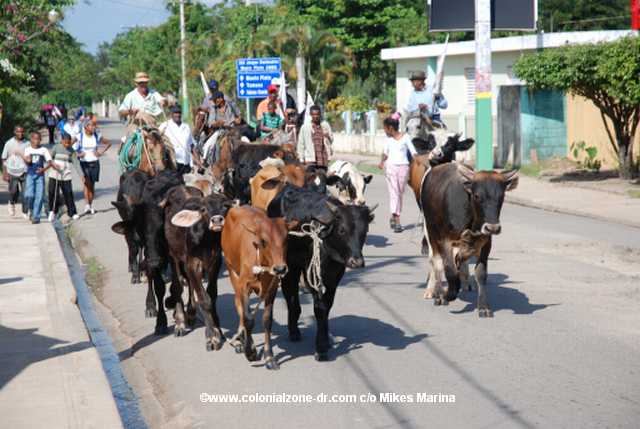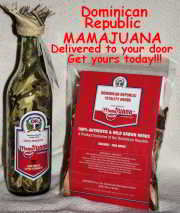
A few weeks before the festival the Commissioners of Santo Cristo de los Milagros go around the region collecting bulls. These are offerings from the believers as an expression of thanks for the favors bestowed on them that year and to signify their faith and devotion. The dawn of the 28 of December the horseback riders, bull wranglers, Commissioners and the faithful enter the town square with their bulls in tow for a consecration ceremony displaying the solemnity of their faith. This procession is not a silent one. Just the opposite It is led by the Banda Municipal de Música. There are songs, prayers, dancing, and even fireworks. All transpiring while the bulls are led to a coral in the center of town. Here these bulls are held for the 4 day festival. Waiting for the 4th day , January 1st, when they will be sold. or "offered". The people gathered here, including the people gathering to purchase these sacrificial bulls, are all in a joyful spirit. There is Sancocho served and liquids imbibed such as rum, jengibre and coffee. The night is passed singing and chanting cantos de toros/ songs of the bulls and salves. These songs are improvised verse and poetry sung a cappella. The singing is done in a round, with alternate soloists taking the lead and the people joining in like a choir. It is a real party spirit. There is much commotion and fireworks
January 1st people begin arriving from throughout the country to participate in the masses and offerings to Santo Christ. After eating the faithful gather at the altar and, in a very solemn ceremony, they ask for and are also thankful for, things and promises granted by the Santo Cristo for the past year and the year to come. This as a very inspirational and somber act. After this ceremony the commissioners, nuns, priests and believers go to the corral where the bulls are kept to hold the sale. The money coming from the sale of these offered bulls will be used by the Catholic Church for good works.
This festival has been occurring for more than 400 years. These observances began with the foundation of the town of Bayaguana in the 1604, during the Spanish colonization
It is said that there were several miracles attributed to Santo Cristo de los Milagros that are recognized during this festival:
*The image of the son of God appeared to a little girl and the sight of her blind mother was immediately restored.
*A paralyzed man, wanting to participate in the festival stood and walked.
*On the day in 1924 the North American troops left Santo Domingo the church bells rang by themselves
The Festival El Santo Cristo de Bayaguana / Offering of the Bulls
In the town of San Juan Bautista de Bayaguana, known simply as Bayaguana, in Dominican Republic is a exceptionally unique festival. The Festival El Santo Cristo de Bayaguana, also known as the Festival of the Bulls, the traditional cattle festival in Bayaguana. The festivities start on December 28 with the arrival of the bulls and end on January 1st with the offering of the bulls.
This tradition started when, during a long drought, the cattle were dying. The crops and fruit were drying up. So, in desperation, the people of the area offered a bull to Santo Cristo in exchange for rains to fall. After a few days passed the rains did return as usual and all was saved. Thus the tradition began.
Dominican Cowboys leading the bulls into the town of Bayaguana
to see more pictures of this festival go to our pictures page
The Town of Moca has a legend: "¡Llegó un jinchaito de moca!"
According to legend families living in the area in the early 20th century were people of white color with straight hair, blue eyes and a little plump. These families used the water from the stream Juan Lopez for their water supply. Along came a drought and the stream dried up almost completely leaving only areas where there were large "puddles" of water. After a time these small reservoirs became contaminated but these people living in this area had no other place where they could get their water. Using this water gave them a swollen (in Spanish the word is hinchadas) appearance so when they went to town the people called them `the jinchaítos of Juan Lopez''
This name is still used. The Mocanos (The name given to the inhabitants of the Moca area) still hear ‘‘¡Llegó un jinchaito de Moca!’’/"There goes a Jinchaito from Moca!" This is where they got their carvaval personage of the Jinchaito. To read more about the carnival characters and to see some pictures of carnaval ( we have some pictures of carnival in Moca in out collection also) check our these pages.

|
|

site map Copyright © 2005 - 2014 All Rights Reserved. Colonial Zone-Dominican Republic (DR)
Home | Calendar | Night Life/Dining | Sight Seeing | Pictures | Businesses | Artists | Food | Helps | History | Language | Music | Media | Pastimes | Products | Tradition/Legend | Links | About Us | Buy Mamajuana | News Blog | DR Gringa's Life Blog | Dominican Dog Blog | Web Designer

Custom Search




MENU
IN COLONIAL ZONE
THINGS DOMINICAN
If you found my web site useful please consider making a donation through Pay Pal . Thanks!


Home | Dining & Night Life | Hotel | Sights | Pictures | Music | Colonial Zone Map | Hot Spots! Directory | Site Search
Traditions and Beliefs/ Tradiciones y las creencias
Our complete exchange rate tool.
Gracias a coinmill.com



